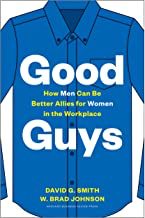By William Carmichael
In all probability, I will anger some of our male readers with my opening remarks. Rarely have I come across a book that tells it like it is so quickly. That we men in the workforce, yes . . . “us guys,” created the gender disparities that exist today. And not just created it, we have the audacity to perpetuate it! Somehow, we feel that gender inequality is a women’s issue; therefore, we never feel any responsibility to fix it. We talk a good game about promoting an inclusive environment but our actions are not so convincing. Men, (and I mean that literally) the book I review here is a wake-up call and the real answer may be staring us in the face. Women are not the enemy. They are our allies and should be treated as such! The problem is that we men don’t know how to treat them as allies. In Good Guys: How Men Can Be Better Allies for Women in the Workplace, authors Dr. David G. Smith and Dr. W. Brad Johnson provide a practical, research-based guide for how to be a male ally to women in the workplace.
Effectively Managing in the #MeToo Movement
To be completely honest, I think that most men, myself included, feel a bit excluded from the #MeToo movement. It’s not that we don’t feel it is important . . . we do! It’s just that we don’t feel it was a positive catalyst to move men to action or to make badly needed behavioral change in the workplace. If anything, it moved some of us in the opposite direction thereby aggravating already chronic gender disparities. This is where our authors can help. Good Guys distills the latest science research and shares evidence-based practices to help men become better allies.
They address “good guys,” or male would-be allies who want to help end workplace gender inequities but don’t know what to do and provide simple instructions, including ready responses to sexist jokes (“Not cool” or “We don’t do that here,” among others) and questions to ask oneself to help gauge a meeting’s inclusivity (“Who is getting interrupted?”) which I talk about a little later. The authors provide helpful advice on how to get past one’s misgivings and get started as an ally, deploy privilege appropriately by realizing its limitations for other people (such as how women of color might not feel comfortable adopting a white male’s brashness), and advocate for women at both the individual and organizational levels. Smith and Johnson also walk the walk as almost all their quotes are from women. The direct and useful advice should make this an obvious choice for men who appreciate the book’s central message: “You can and should do more.”
Good Advice Men Can Use
What our authors provide in Good Guys is a healthy dose of reality to those who don’t perceive gender inequities in the workplace “at all” and as Drs. Smith and Johnson attest, “It’s hard to fix what you can’t see. Another challenge is that men are unsure of how to take action so they often simply decide not to. As Smith and Johnson show us, “The skills men need to better allies for women at work also make them better allies to someone of a different race, sexual orientation, or background.”
Part of this reality also comes from early in Chapter 1 where the authors make an incredibly brash statement in a section titled It’s Good to Be a Man in the Workplace where it opens with “The workplace was created by men, for men, to do men’s work. Because men are the workplace norm, the entire business and workplace environment is based on men, with a few exceptions (e.g., women’s restrooms). Impetuous or not, there’s a great deal of subconscious truth that men feel about this. It’s almost like- “How dare they invade our space!” Men, we’ve got to move past this caveman mentality and Good Guys shows us how. As an example, I found the Ally Actions at the end of Chapter 5- Trust and Reciprocity in Friendships with Women to be especially helpful.
Equally helpful were the Ally Actions at the end of Chapter 7- Meetings: Dangerous Places If You’re Not a Dude. As we all know, meetings can be a treacherous place around the table when testosterone levels tend to compete with one another. You know it’s going to happen. . . what the authors refer to as “manterruptions,” where a male will cut short what a female has to say. Someone, another male, needs to take ownership of this and again, our authors show us how it can be done, effectively, professionally, and respectfully. Guys, this is good stuff!
Structure and Layout
Well researched and cited (a quick perusal of the Notes Section alone indicates an enormous amount of recent, peer-reviewed, credible sources), educators Smith and Johnson go beyond the traditional textbook look and feel to one of a practical field guide. There is substance here as well as application.
At 216 pages, Good Guys is organized into three parts: 1) Interpersonal Allyship, 2) Public Allyship, and 3) Systematic Allyship. Its ten chapters comprise sixty action-oriented strategies that will help any male manager develop their own personalized ally action plan.
Linear by design, readers will benefit from a front to back read but once again, be prepared for some honest truth very quickly.
| Part | Chapter | Main Focus |
| 1 | Men: The missing ingredient in gender equity | |
| 1 | 2 | How to develop your gender intelligence (GQ) |
| 3 | How be a better ally at home | |
| 4 | How to capitalize on interactions at work | |
| 5 | How to develop a personal board of advisors | |
| 2 | 6 | How to become a proactive ally |
| 7 | How to handle ubiquitous inequities | |
| 8 | How to effectively sponsor and support women in the workplace | |
| 3 | 9 | How to vanquish inequities |
| 10 | How to grow a robust community of allies |
Filled with firsthand accounts from both men and women, and tips for getting started, the book shows how men can partner with their female colleagues to advance women’s leadership and equality by breaking ingrained gender stereotypes, overcoming unconscious biases, developing and supporting the talented women around them, and creating productive and respectful working relationships with women.
Who Will Benefit Most from This Book? Male management (at all levels!)
About the author: David G. Smith, PhD, is a professor of sociology in the National Security Affairs Department at the US Naval War College. W. Brad Johnson, PhD, is a professor of psychology in the Department of Leadership, Ethics, and Law at the US Naval Academy and a faculty associate in the Graduate School of Education at John Hopkins University.

Strayer University william.carmichael@strayer.edu www.strayer.edu
